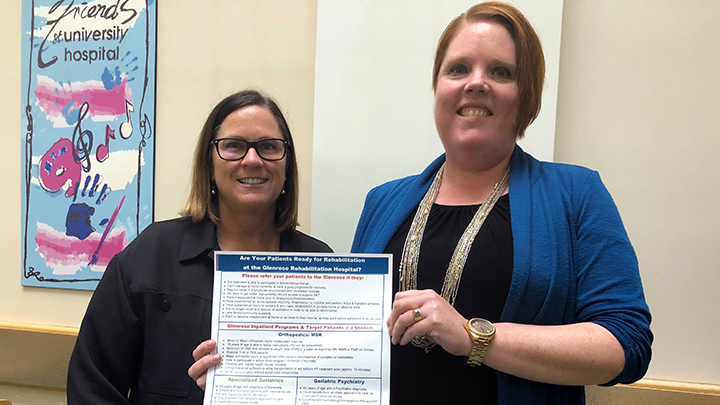
November 12, 2019

Sandra Tisi, left, patient care manager at the Royal Alexandra Hospital, and Mareika Purdon, manager of patient transitions at the Glenrose Rehabilitation Hospital, showcase the work they’ve done on developing a poster — a simple one-stop reference tool — that describes target patients for Glenrose inpatient programs. It allows any member of a interdisciplinary team from another site to identify a Glenrose patient, which ensures patients receive the right care in a timely manner and in the right place. Tisi and Purdon co-designed the poster with a number of frontline staff, including transition coordinators, rehab navigators, managers, social workers, Nurse Practitioners, community and patient and family representatives.
Story & photo by Vanessa Gomez
EDMONTON — A fresh centralized team approach is helping patients in other facilities get to the Glenrose Rehabilitation Hospital (GRH) quicker for their rehabilitation.
For the Glenrose, it’s all about helping patients receive the right care at the right time and in the right place.
The facility’s new approach came about following a year of focus groups with staff, patients and families. Their feedback led to the creation of a centralized team — complete with rehab navigators and social workers to help optimize patient flow — which now helps patients and staff easily access the Glenrose from across the continuum of care.
“Through our relationships with managers, staff and physicians from other sites we’ve been able to develop a team approach across the continuum of care,” says Mareika Purdon, manager of patient transitions. “We’ve really been able to rally the teams from all sites to do collaborative work.”
She adds that, with a single referral form and clearer intake criteria, the Glenrose has been able to clarify: “Who are the patients that should be accessing the Glenrose and how can we get them over quickly?”
This new criteria is helping the GRH to address challenges such as waiting lists, inconsistent intake processes and limited coordination. Rehab navigators, patient representatives, family care advisors and interdisciplinary teams (from across all sites) have helped create a more fluid process between intake and discharge.
The work has since expanded to be recognized by Accreditation Canada with its Trauma Distinction accreditation. Trauma patients need to meet specific wait-time-to-rehab targets. These include transfers from acute care to the Glenrose within eight days. As well, patient flow initiatives are identifying patients at risk of falling between the cracks to ensure they have access to the services they need.
The team recently hosted a co-design session where frontline staff from across the continuum of care — transition coordinators, rehab navigators, managers, social workers, Nurse Practitioners from acute care, Glenrose, and community and patient and family representatives — met to develop a poster that would describe target patients for Glenrose inpatient programs.
This simple one-stop reference tool helps any member of an interdisciplinary team from another site to easily identify a Glenrose patient. Staff also suggested the poster be made available in rooms where teams are doing rapid rounds so the information is always readily available
“There are often complex patients who require the interdisciplinary team to find the right fit,” says Sandra Tisi, patient care manager in the surgery program at the Royal Alexandra Hospital.
“Building a strong foundation of relationships across the continuum of care has helped mobilize those patients to receive the appropriate care they need.”
This work at the Glenrose did not go unnoticed.
The team was nominated for a President’s Excellence Award for Outstanding Achievement in Quality Improvement, validation that the Glenrose is stepping in the right direction towards better patient flow.
“We enjoy the work and we’re able to solve more complex problems,” says Purdon, “because we continuously work to build those trusting relationships.”